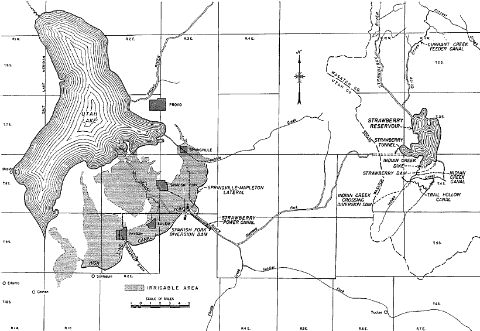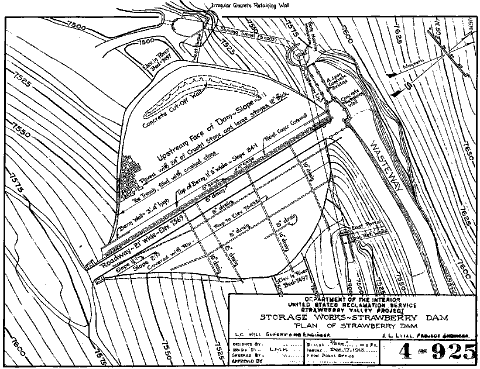 | Click Here for a PDF (printer friendly) version |
In 1847, the first Mormon settlers entered the present state of Utah. They entered a part of the Great Basin Desert, arid and uninviting. The Mormons spread out across most of the land they called Deseret, some going to the southern Utah Valley. They soon began farming the few tracts of arable land in the valley that received sufficient water. As early as 1847, settlers near Utah Lake first diverted the nearby rivers and streams for irrigation. The close-knit cooperation among members of the Church of Jesus Christ of Latter Day Saints provided a basis for Utah citizens to work closely, and fairly easily together on subsequent projects. The tradition of cooperation led to the relative smoothness of the negotiations by the citizens of Utah and Wasatch Counties with Reclamation in creating the Strawberry Valley Project.
PROJECT LOCATION
The Strawberry Valley Project, part of Reclamation's Upper Colorado Region, is located in Utah and Wasatch Counties, in central and eastern Utah respectively. The project is centered in Utah County near Spanish Fork, Utah, including the Spanish Fork River. In Wasatch County the project includes Strawberry Dam and Reservoir, located approximately 29 miles southeast of Provo. Wasatch County also includes Indian Creek Dike, the Currant Creek Feeder Canal, Indian Creek Canal, Trail Hollow Canal, Indian Creek Crossing Diversion Dam, and most of the Strawberry Tunnel, that diverts water from Wasatch County to Utah County through the Wasatch Divide.(1)
The western most section of the Strawberry Tunnel was located in Utah County. Utah County contains other major features of the Strawberry Valley Project including the Strawberry Power Canal, the Springville-Mapleton Lateral, the Upper Spanish Fork Powerplant, the Spanish Fork Diversion Dam, the Lower Spanish Fork Powerplant, the Payson Powerplant, and the High Line Canal. Reclamation and the Strawberry Water Users' Association built the project to irrigate greater amounts of arable land in southern Utah Valley.(2)
HISTORIC SETTING
Utah Valley, in Utah County, Utah is located at the eastern edge of the Great Basin Desert. Utah Valley remains very dry and ill-suited for agriculture without irrigation. When the Mormons first settled Utah Valley in 1847, water proved a very scarce commodity. As Utah Valley's population grew, the need for more farm land increased. In 1860, Utah Valley settlers began diverting the waters of Spanish Fork River, and smaller streams, for irrigation. However, this supplied sufficient water only during the heavy runoff months of May and June. Afterwards, water levels dropped severely, providing only enough water to irrigate about 12,000 acres of farmland. Occasional heavy snowfall seasons provided adequate water for 30,000 acres of farmland throughout the growing season, but such years occurred infrequently.(3)
As a result of the extremely limited water supply, only a small percentage of land in Utah Valley could be farmed with any certainty of adequate water during the entire growing season. Continuing population increases in Utah Valley, and the lack of sufficient water for arable lands, the need for supplemental water from storage facilities became apparent long before 1900. Utah Valley desperately needed reliable sources of water.(4)
Around the turn of the century Utah State Senator Henry Gardner and John S. Lewis, visited Strawberry Valley, in Wasatch County, in the upper Colorado Basin; on a camping trip. During the trip they developed an idea for a reservoir in the valley, and a system to transport water through the Wasatch Divide, that separated the Colorado Basin from the Great Basin. Officials of the Spanish Fork East Bench Irrigation and Manufacturing Company investigated the project and in August of 1902, filed for reservoir purposes on the Strawberry River, and for power purposes on the Spanish Fork River.(5)
The group hired an engineer who conducted preliminary surveys and made water filings. The resulting report showed the project required more money than the company, or even all the citizens of the valley could afford. Utah Valley residents appointed a committee requesting a Reclamation investigation of the project's feasibility. The committee asked that construction begin as soon as possible, if the project proved feasible.(6)
PROJECT AUTHORIZATION
Reclamation carried out preliminary investigations in 1903 and 1904. Reclamation Engineers Frank C. Kelsey and George Swendson, and Halen &Halen, a company hired by Reclamation, performed the initia surveys. On October 2,1905, a board of engineers determined the project was feasible.(7) On December 15, 1905, the Strawberry Valley Project received approval provided that: conflicts of water rights claims were resolved; enough acreage was secured for irrigation to reimburse Reclamation on the cost of construction; "and that a clean-cut feasible reclamation project, free from all complications of any kind or character be secured before a dollar is spent on construction."(8) A special clause in the Reclamation Act of 1902 allowed the Utahans in Utah Valley to pool enough land to receive project approval. The clause allowed residence "in the neighborhood", instead of residence on the land, as required by the Reclamation Act. The provision was inserted in the act especially for Utah projects because of the settlement pattern of Utah farming towns, in which many farmers did not live on their farm land.(9)
The location chosen for Strawberry Dam and Reservoir presented some social problems. The reservoir area occupied land belonging to the Uintah Indian Reservation. Senator Reed Smoot, of Utah, who pressed for a Reclamation project in his state, pressured Congress to remove the reservoir area from the Reservation land. Congress followed his wishes and turned the land over to Reclamation.(10)
On March 6, 1906, work was authorized to begin by force account and contracts. Initial work included repairing and extending the wagon road from a shipping point on the Denver and Rio Grande Western Railway line to both ends of the Strawberry Tunnel, construction of buildings for men and animals at the D. &R.G.W. railhead, and the opening of both tunnel portals for bidders to determine the nature of the materials encountered in excavating the tunnel. A board of engineers convened in Salt Lake City to open bids for the construction of the tunnel. The board received no bids and recommended construction of the tunnel by force account.(11)
Secretary of the Interior Ethan A. Hitchcock approved the board's recommendation, and Reclamation authorized force account work on September 14, 1906, with certain conditions. The conditions directed the supervising engineer to proceed at a rate he considered expedient to deal with any difficulties encountered. Reclamation authorized him to purchase tools and labor necessary for excavating the tunnel without the construction of an expensive power plant. Reclamation was to re-advertise the excavation to bidders around May 1, 1907.(12) In 1906 the Spanish Fork irrigation companies disbanded, resulting in a repayment contract between Reclamation and the Strawberry Water Users' Association.(13)
CONSTRUCTION HISTORY
Water travels a great distance and through many structures of the Strawberry Valley Project to reach the farms of southern Utah County (see Drawing 1). The Strawberry River feeds directly into Strawberry Reservoir. The Currant Creek Feeder Canal, built in the 1930s by the Strawberry Water Users' Association, drains water from Currant Creek into Co-op Creek, which in turn flows into the Strawberry River. The Indian Creek Feeder Canal and the Trail Hollow Canal divert water from their namesake creeks. The Trail Hollow Canal drains into the Indian Creek Canal, which drains into the reservoir. The Indian Creek Crossing Diversion Dam diverts the water from Indian Creek into the canal.(14)
Drawing 1. Schematic for the Strawberry Valley Project
 | Click on the image for a larger version. |
Water from the reservoir flows through Strawberry Tunnel into Six Water Canyon. The water then travels to the Diamond Fork River, then flows into the Spanish Fork River. The Spanish Fork Diversion Dam pushes the water into the Strawberry Power Canal, feeding the Upper and Lower Spanish Fork Powerplants. The High Line Canal and the Springville-Mapleton Lateral divert water from the Power Canal and transport it across farmland southeast of Utah Lake. The canal and lateral send the water into the existing irrigation system of the southern Utah Valley farms.(15)
Actual construction began in August 1906, when work commenced on the Strawberry Tunnel under Supervising Engineer Louis C. Hill. James Lytel and George Swendson were Project Engineers. Later records indicate Lytel became the sole Project Engineer as the project progressed. The construction proceeded as a mixture of Reclamation force account work and contract work.(16)
Reclamation constructed three roads to provide access to construction sites in Wasatch County. The Diamond Fork Road extended and improved an existing wagon road, from the Denver and Rio Grande Western line to the West Portal of the Strawberry Tunnel. Reclamation constructed it in 1906, and crews extended the road to the East Portal later in the year. Built in 1911, Horse Creek Road travelled from Diamond Fork Road to Strawberry Dam. High Line Road stretched from Indian Creek Dike to the East Portal of Strawberry Tunnel.(17)
Reclamation established a temporary settlement, Diamond Switch, at the project's shipping point on the Denver and Rio Grande Western rail line. After Reclamation graded the site, the Denver and Rio Grande installed a ten car siding. Reclamation built three dwellings at the site including the clerk's residence, an office with guest rooms, and a mess hall. Three corrugated iron storehouses housed cement, equipment, hardware and other supplies. A bunkhouse housed laborers at Diamond Switch and workers on their way to the Strawberry Valley construction sites. Other buildings at Diamond Switch included a hay barn and a barn for sixteen horses.(18)
Excavation began on the West Portal of the Strawberry Tunnel in late August 1906, with one work shift(see Photograph 1). It increased to two shifts in the middle of September. Reclamation built a large camp to house 75 men at the West Portal of the tunnel during September, October, and November, 1906. Reclamation also constructed a small powerhouse with gasoline generators, to provide electricity for the Adams drills initially used in the tunnel excavation.(19)
Though the Adams drills proved unsatisfactory for the work, the excavation continued with their use through the winter of 1906-07. Reclamation ventilated the tunnel by drawing stale air out through a 14 inch pipe. This in turn drew fresh air into the excavation. Reclamation crews installed 8 x 8 inch timbers supported the tunnel. These timbers continued for 1,500 feet. Electric locomotives hauled the excavated material out of the tunnel in "muck cars." The muck consisted mostly of sandstone and limestone in broken strata that made drilling and shooting difficult.(20)

Photograph 1. Force-account crew standing in front of the West Portal, Strawberry Tunnel. Circa 1907
Construction continued until July 20, 1907, when work stopped for an indefinite period due to lack of funds. In the meantime, a study showed the tunnel drilling could continue more cheaply with hydro-electric power, and Project Engineer James Lytel recommended a hydro-electric plant on the Spanish Fork River. This received approval and preparations for work began. During the shutdown, Reclamation discharged all tunnel workers, closed the West Portal camp, and left two watchmen to provide security for the empty camp. Reclamation furloughed F.W. Cater, the tunnel's Construction Engineer, following the shut down, and reinstated him December 11, 1908, when work resumed.(21)
During suspension of construction on the tunnel, crews rushed to finish both the hydro-electric powerplant on the Spanish Fork River, and the power canal providing it with water (see Photograph 2). Work began on the Power Canal on May 1, 1907. Reclamation cut the labor force down on October 1 of the same year. The smaller labor force continued on the canal through the winter of 1907-08. Excavation finished in the spring of 1908, and the laborers began laying the concrete.(22)
The Power Canal's route travelled it through rough country making construction fairly difficult (see Photograph 3). The Denver and Rio Grande right of way further hampered construction by forcing Reclamation to build tunnels and deep cuts to bypass the right of way. Many of the construction crews had more experience in railroad work than in building canals and did not understand canal operations well. Reclamation brought in a superintendent and some foremen, experienced in canal work, to help the inexperienced crews. As stated earlier, Reclamation first let water into the canal on December 13, 1908. Both the canal and the Upper Spanish Fork Powerplant began operation on December 15, 1908. Water flowed through the canal on December 13, 1908. Work crews completed the powerplant on January 10, 1909 (see Photograph 4).(23)
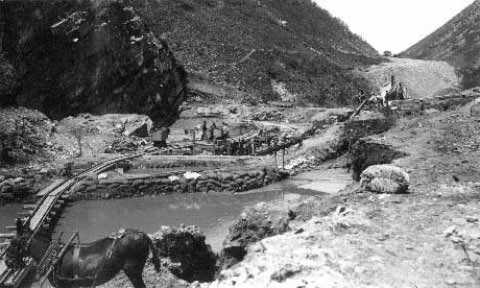
Photograph 2. Reclamation Service pushed the construction of the power system (including the Spanish Fork Diversion) to provide electricity for tunnel construction. Circa 1907.
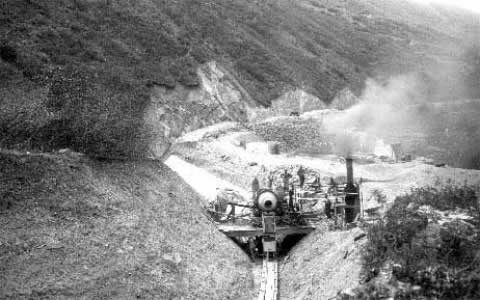
Photograph 3. The majority of the Power Canal traversed steep slopes and had to be concrete lined. Circa 1907.
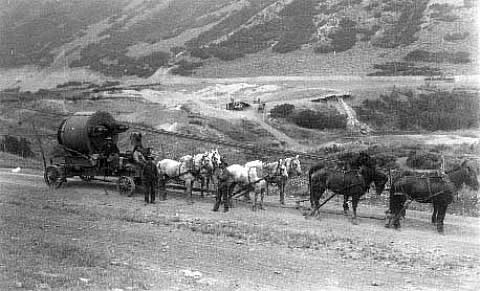
Photograph 4. The majority of the Power Canal traversed steep slopes and had to be concrete lined. Circa 1907.
In September 1908, a crew went to the West Portal to build a substation capable of furnishing power for compressed air drills. On December 9, 1908 construction resumed on the Strawberry Tunnel. The crew temporarily continued with the inefficient Adams drills. On January 13, 1909, with hydroelectric power available, one shift began using three and one quarter inch Sullivan Air Rock drills. A second shift started work on January 18, and the third shift began working on March 15 of the same year.(24)
While drilling on December 28, 1910, workers encountered water flow of about seven second feet. The water slowed tunnel construction and made working conditions very disagreeable. The continuous flow of water forced workers to wear raincoats and boots, but the equipment did little good. Workers constantly left the tunnel soaked to the skin from working their whole shift in water. The work crew began lining the tunnel with concrete in October 1910.(25)
Work crews opened operations on the East Portal of the tunnel September 20, 1911. Hand drilling on the actual tunnel excavation began October 14, but crews switched to air drills in November. They mostly encountered water permeable sandstone in drilling, and water became the major problem for work crews. They had to pump water out of the tunnel because the excavation from the east portal travelled down hill. Water caused delays when the pumps occasionally ceased operating, and the tunnel flooded. (26)
Work continued on the tunnel through 1911 and early 1912. The drilling crews finally broke through on June 20, 1912 at 7:00 A.M. The survey work proved excellent; the joint of the 19,091 foot long shaft was only slightly more than two inches off. Laborers continued lining the tunnel with concrete until completion on December 13, 1912 (See Photograph 5).(27)
The West Portal Camp sat at an elevation of 7,650 feet, and during the winter of 1908-09, 300 inches of snow fell on the camp. Of that total, 91 inches fell in January alone. Because of these conditions, the West Portal Camp contained certain necessities for the workers living there. There were a commissary, a mercantile store with a small stock of merchandise, a boarding house, and a pool room. A hospital carried a minimum of instruments and medicine, primarily for injuries and the general health of the men, and a doctor stayed at the camp at all times. Reclamation also established branches of these operations in the camps at the East Portal and Strawberry Dam.(28)
When completed the Strawberry Tunnel extended for 3.8 miles. It had a capacity of 600 cubic feet per second. The tunnel was seven feet wide and nine feet high with an arched ceiling. The entire structure was lined with concrete. Strawberry Tunnel diverts water from Strawberry Reservoir to Diamond Fork River. Diamond Fork River flows into Spanish Fork River to Spanish Fork Diversion Dam (See Photograph 6).(29)
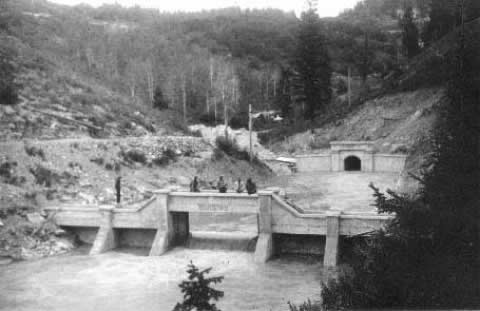
Photograph 5. Water first flowed out of the Strawberry Tunnel, West Portal, on September 13, 1913. Circa 1913.
Work crews began excavation for the Spanish Fork Diversion Dam in October 1907. Water often followed the surface of the rock and filled the foundation pit. A lack of journeyman carpenters created more problems in completing the proper form work for the concrete. The Spanish Fork Dam was an ogee weir constructed of rubble concrete. Crews hauled sand and gravel for the concrete from a gravel pit one and a half miles away. The rubble portion of the concrete mixture contained rocks, one to three cubic feet in size, excavated from the site. The rock eventually comprised 24 percent of the total volume. Work crews finished the dam on July 1, 1908.(30)
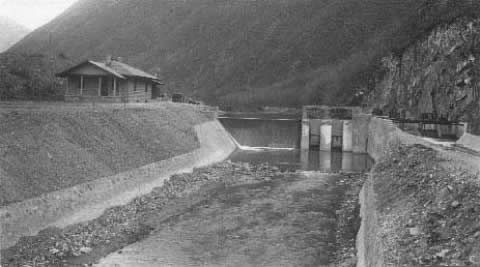
Photograph 6. Water was first diverted into the Power Canal on December 13, 1908. The gate keeper's house was added in 1909. Circa 1909.
Work commenced on the Strawberry Dam camp and stripping of the dam site on June 18, 1911. Laborers excavated the corewall trench through the rest of the year, though they did not finish it before the December 1911 (see Photograph 7). The crews poured the concrete for the corewall up to the elevation of the river bed, as much as the excavation allowed, before cold weather forced work to stop. At the south end of the dam site workers established a crushing and concrete mixing plant, transferred to Utah from the Salt River Project (see Photograph 8). Cold weather halted work on the dam on December 10, 1911, and the camp closed down.(31)
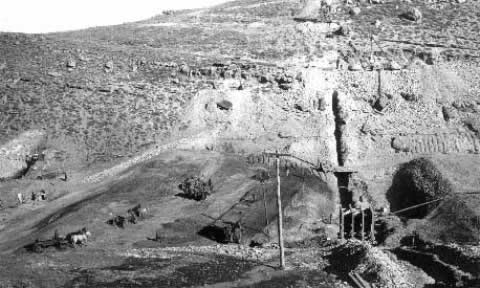
Photograph 7. While horse-drawn wagons delivered thousands of loads of earth fill to the Strawberry Damsite, the core wall trench was being excavated. Circa 1911.
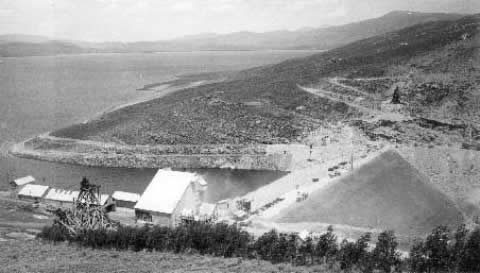
Photograph 8. Crushing and mixing plants from Reclamation Service's Salt River Project, Arizona, were erected at Strawberry during the Summer of 1911. Circa 1911.
Work resumed in the spring of 1912, and James Lytel, the Project Engineer, closed the sluiceway on July 14 to begin filling the dam. Workers finished the dam, except for the spillway on October 29. Reclamation reoccupied the dam camp site on June 1, 1913, to begin work on the spillway, located on the north side of the dam. Laborers dug 8100 cubic feet of rock and material out of the spillway section. A 64 foot reinforced concrete bridge stretched across the spillway. Workers completed the spillway on September 20, 1913 (see Photograph 9).(32)
Strawberry Dam was an earthfill dam 72 feet high and 490 feet long containing 118,000 cubic yards of fill. The dam was 366 feet wide at its maximum base width and 21 feet wide at the crest. The reinforced concrete corewall sat 18 feet from the crest, in the center of the dam, on the upstream side. The corewall was four feet thick at the base of the dam in solid rock and progressively thinned to three feet, two feet, and 18 inches as it approached the crest.(33)
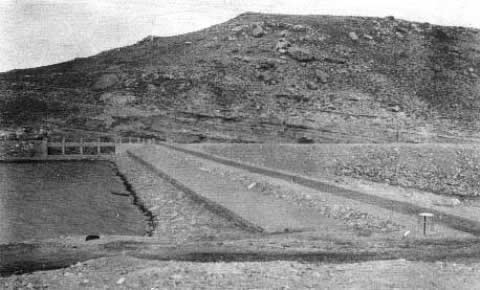
Photograph 9. Water starting to rise behind the newly completed Strawberry Dam. Circa 1915.
Drawing 2. Final Plan for Strawberry Dam and Spillway
 | Click on the image for a larger version. |
Indian Creek Dike was necessary to prevent loss of water into Indian Creek. The dike's construction was similar to that of Strawberry Dam. Reclamation awarded the contract for the dike construction to W.O. Morrison Company of Denver. The company began work in July 1911. In digging the corewall trench laborers encountered quicksand at a depth of nine feet. The quicksand bed measured as deep as ten feet and about three hundred feet across. Morrison drove tongue and groove pilings into the bed for nearly the entire distance to support the corewall. Work on the dike shut down because of freezing weather on October 27, 1911, resuming in spring of 1912. Morrison poured the last load of gravel and crushed rock on the paved berm for the roadway across the dike on September 17, 1912.(34)
Workers built the corewall of the dike 18 inches thick in bedrock at the base, and tapered it to 12 inches at the crest. The corewall stood 17.6 inches from the center of the dike. The dike was earthfill containing 114,000 cubic yards of material. The structure was 37 feet high and 1311 feet long. The maximum base width was 198 feet with a crest width of twenty feet. The company completed the dike in October 1912 (see Photograph 10).(35)
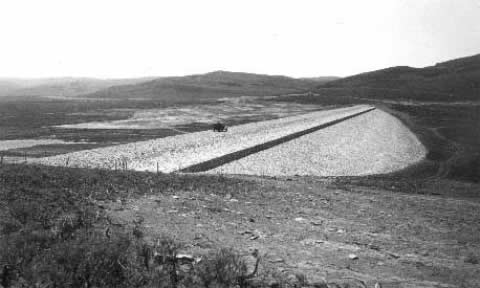
Photograph 10. Hand-layed masonry on the upstream side of the completed Indian Creek Dike. Circa 1912.
Reclamation awarded the contract for the Indian Creek Feeder Canal and the Trail Hollow Canal to the Ely Construction Company of Springville, Utah. Midwest Engineering Company of Omaha, Nebraska, received the contract for the construction of the terminal drop and chute, and W.O. Morrison received the contract to construct the intake structures and bridges. Ely Construction completed the Indian Creek Canal and the Trail Hollow Canal in September and November 1912, respectively. The Indian Creek Crossing Diversion Dam was finished on November 5, 1912. The dam was constructed as an earth dike 12 feet high, 1350 feet long, and it contained 15,000 cubic yards of material.(36)
Construction of main canals to the cities and towns in southern Utah County ran into difficulties during negotiations between Reclamation and the Strawberry Water Users' Association (SWUA). On March 25, 1914, Secretary of the Interior Franklin K. Lane abrogated the contract between the Interior Department and the SWUA at the request of the association. The water users' association claimed Reclamation could obtain better results by dealing directly with the individual units. The Spanish Fork unit, the High Line unit, and the Lake Shore unit settled contracts in 1915. The Mapleton unit failed to gain the required acreage to receive a contract in that year.(37)
For construction purposes, Reclamation split the main canal in the High Line Canal system into four divisions. The construction company of Mendenhall, Straw, and Bird of Springville, Utah, began work on the first division on December 21, 1914. Rideout and Andrews of Draper, Utah, contracted to build Division Two. McArthur Brothers of New York City received the contract for Division Three, and the Reynolds-Ely Construction Company of Springville built Division Four. This took care of the main section of the High Line Canal. The main section of the canal originated at the Upper Spanish Fork Powerplant near the mouth of Spanish Fork Canyon and travelled, generally southwest, approximately 17.9 miles. Work crews completed the main canal, including laterals, on December 1, 1916 (see Photographs 11,12, 13, 14). Final work on the High Line Canal system concluded in June 1917. The entire High Line Canal system ran approximately 77 miles with about 62 miles of it concrete lined.(38)
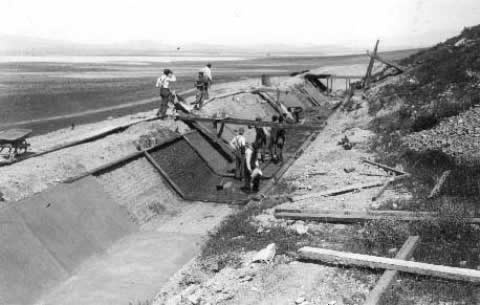
Photograph 11. Construction work on a concrete-lined portion of the Highline Canal Circa 1915.
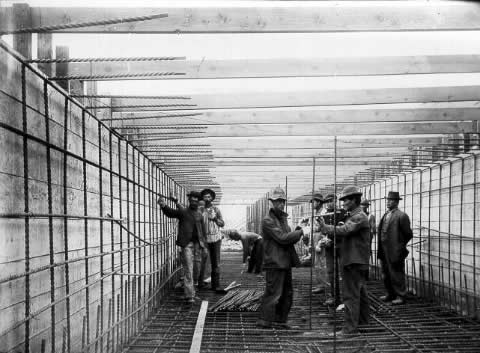
Photograph 12. Construction on a box-flume portion of the Highline Canal Circa 1915.
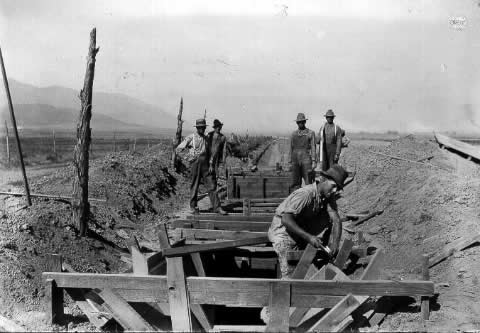
Photograph 13. Construction work on a Highline Canal lateral located north of Santaquin Circa 1915.

Photograph 14. Completed in 1917, this barrel flume (today abandoned) delivered water to the only public lands under the Reclamation Act. Circa 1917.
Construction began on the Springville-Mapleton Lateral in 1918. The work on sections A through F was done by force account because Reclamation considered the bids to high for the project. Contractors did some of the excavation work, but the bureau handled the rest by force account, completing the lateral in the same year. When completed the Springville-Mapleton Lateral was 6.75 miles long. The earthen section of the Lateral had a base width of four feet with a water depth of 2.71 feet. The four inch thick, concrete lined section had a base width of four feet and a water depth of 2.55 feet.(39)
POST CONSTRUCTION HISTORY
Even before completion of the Strawberry Valley Project two slight earthquakes in July and September 1915, respectively, caused Strawberry Dam to settle, but caused no damage. The July earthquake also caused the Indian Creek Dike to settle. Seepage through the dam, not associated with the earthquakes, reached as high as 4.75 second feet in 1915. Workers determined the area of seepage and covered it with two feet of lose earth. This effectively stopped the seepage.(40)
The Spanish Fork Dam raised the water of the Spanish Fork River 16 feet. This backed the water up three quarters of a mile into Spanish Fork Canyon and flooded 8.2 acres. The Denver and Rio Grande Western Railway's right of way made up part of the flooded land. The D. &R.G.W. protested the flooding, saying it would weaken the embankment and endanger railroad operations. To appease the railroad company, Reclamation agreed to widen the track bed for 500 feet along the line, and then line the slope with a six inch layer of concrete.(41)
Road maintenance and construction became a major concern for crews before completion of the project. The Federal Government and Utah County combined to maintain the Diamond Fork Road. About thirty owners, who bought houses on the West Portal camp site, persuaded the Utah County Commission to appropriate funds for the road's maintenance. The county raised sections of the road to prevent erosion by the stored water. Reclamation built bridges across Diamond Fork Creek to ease creek crossing during wet weather. Frost and the cold continually damaged concrete structures enough to warrant constant repairs. Reclamation frequently returned to the project to effect these repairs. To reduce damage, crews waterproofed all concrete structures, except tunnel linings, the gate shafts, and submerged concrete.(42)
After receiving control of the Strawberry Valley Project, the SWUA did not hesitate to make additions to existing facilities. In the 1930s, the association built the Lower Spanish Fork Powerplant on the power canal, and it began operation in 1937. Later, the association built the Payson Powerplant, and it started operating in 1941. The Lower Spanish Fork Plant contained one generator with a 250 kilowatt capacity. The Payson Plant had one generator of 400 kilowatt capacity.(43)
Some of the Strawberry Valley Project's major structures did not last. Severe flooding of the Spanish Fork River in 1983 destroyed the Spanish Fork Diversion Dam, necessitating its replacement. A decision to enlarge Strawberry Reservoir resulted in the intentional breaching of Strawberry Dam and Indian Creek Dike in 1985. In 1986, the SWUA concluded the Upper Spanish Fork Powerplant was obsolete, and took it off line to replace it with a more modern facility.(44)
Water remained the most inconsistent element in the Strawberry Valley Project. Flood years, though few and far between, provided enough water for irrigation without the stored waters of the project. During the more frequent drought years nature and the project barely supplied enough water, and the runoff flow varied widely year to year. In 1934, the Strawberry River only discharged 19,300 acre-feet of water, while in 1952, 182,900 acre-feet flowed through it. In 1934, the Spanish Fork River discharged 62,300 acre-feet of water, and released 310,600 acre-feet in 1952. The variation in water availability is typical of Utah, and profoundly affected the amount of land irrigated.(45)
SETTLEMENT OF PROJECT
The various units of the Strawberry Water Users' Association reached a contract agreement with Reclamation to pay the reimbursable construction cost of $3,349,424 in order for the SWUA to take control of the project. To do this Reclamation required the association to pay 51 percent of the cost. The water users assumed full control of the project on October 6, 1926. The different units of the association negotiated three different payment plans; a 20 year plan, a 40 year plan, and a crop production payment plan under the Extension Acts of 1914, 1924, and 1926. The SWUA made the final payment in December 1974.(46)
The project did significantly impact Utah County. Population growth remained steady for many years. Roscoe Flemming claimed in a Denver Post article that Utah Valley's population had increased by 12,000 people before 1955. The Project Histories of the early 1980s showed the project served about 6,000 people and irrigated about 40,000 acres. The repayment of construction costs, with no interest, stirred controversy among many people not dependent on Reclamation projects and irrigation, but others viewed the increased productivity of irrigated areas as ample reward for the lack of interest payments.(47)
USES OF THE PROJECT WATER
The original purpose for the Strawberry Valley Project was, and remains intact -- the irrigation of farmland in southern Utah Valley, and of grazing land both in Strawberry Valley and Utah County. Water from the Strawberry Valley Project provided irrigation for a wide variety of crops (see Photograph 15).(48) Increased agricultural production in the area led to development of agricultural industry, primarily the sugar beet industry.(49) The project quickly evolved into more than just an agricultural project. Water from the project soon provided hydro-electric power for some of the cities in the project area as well as for the project itself. Even before completion of the project Strawberry Reservoir became a haven for recreation oriented visitors.
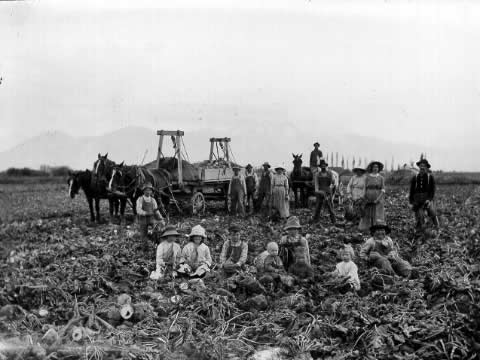
Photograph 15. Sugar beet harvest on the Wm J. Munk farm, Spanish Fork. Circa 1915.
The Strawberry Valley Project expanded over the years, and with it, the irrigation on project lands. The projections called for 50,000 acres on 1,500 farms to be irrigated by the end of the project. Initial irrigation fell short of yearly projections. In 1915, reports predicted 26,177 acres on 908 farms would be irrigated. In fact, only 8,769 acres on 469 farms received irrigation water during the year. In 1916, the project irrigated 26,250 acres on 1,000 farms. Reclamation projected it had enough water to irrigate 53,889 acres on 3113 farms in 1926. Project water actually irrigated 46,453 acres and 2690 farms. The project irrigated 46,084 acres in 1977, a severe drought year.(50)
The Strawberry Valley Project improved grazing land and helped support growth of livestock on the project. In addition, Reclamation leased areas around Strawberry Reservoir to ranchers intent on grazing livestock. The grazing leases brought in $10,000 per year, while still under the administration of Reclamation, before the leases transferred to the water users. Under the water users' association, grazing leases provided a significant portion of the revenue for repayment of construction costs. Irrigation provided water for more grazing land in Utah County. During 1922, land in the Strawberry Valley Project supported 1,850 horses, 20 mules, 6760 cattle, 13,000 sheep, 17,600 fowl, 1,330 hogs, and 274 beehives. In 1922, grazing revenues netted a profit of $17,274.37.(51)
Hydro-electric power quickly became another important product of the project. With the completion of the Power Canal and the Upper Spanish Fork Powerplant to supply power to both construction sites at the reservoir and the city of Spanish Fork, the project became a hydro-electric project. The addition of the Lower Spanish Fork and Payson Powerplants by the Strawberry Water Users' Association strengthened and extended the relationship. Water from the project found its way into other municipal uses. In 1916, Payson entered into a contract with Reclamation for water from the project to supplement the city's water supply.(52)
Recreation did not lag far behind the other uses of the project's water resources. Boating and fishing rapidly became tradition at the reservoir. From July 1 to October 1, 1918, 15 boats were registered on Strawberry Reservoir. In 1921 people registered 51 boats at the reservoir. According to reports, fishing at Strawberry remained very good. Reclamation sold the buildings at Camp Quinton, the West Portal construction camp, to private owners who used them as recreation homes. In addition to boating and fishing, Reclamation set up a bird refuge at Strawberry Reservoir in June, 1918.(53)
CONCLUSION
Before projects like Strawberry Valley, the majority of Utahans faced drought conditions that could only be overcome with difficulty, if at all. Sagebrush and greasewood constituted the predominant plant life. The Strawberry Valley Project succeeded in bringing much needed water to a fertile, but arid section of Utah. Albert Swensen stated, "Before the Strawberry was finished we used to get one crop of alfalfa, and that was it. During a dry year we just burned up."(54) The project brought water from the Colorado River Basin to the Great Basin through the Wasatch Divide. The difficult engineering task required construction of the Strawberry Tunnel extending nearly four miles through the mountains of the divide.(55)

Thomas Alexander History Professor, BYU
on the Strawberry Valley Project
 | Click here to listen to Dr. Alexander |
Success of the project required cooperation between Reclamation and the members of a private irrigation district. Problems did arise, as would be expected, but the Strawberry Valley Project successfully merged with the existing irrigation systems of Utah Valley farmers making greater agricultural productivity possible for the farmers.
ABOUT THE AUTHOR
Eric A. Stene was born in Denver, Colorado, July 17, 1965. He received his Bachelor of Science in History from Weber State College in Ogden, Utah, in 1988. Stene received his Master of Arts in History from Utah State University in Logan, in 1994, with an emphasis in Western U.S. History. Stene's thesis is entitled The African American Community of Ogden, Utah: 1910-1950
BIBLIOGRAPHY
MANUSCRIPTS AND ARCHIVAL COLLECTIONS
Record Group No. 115. Bureau of Reclamation Records. National /archives and Records Administration, Denver, office.
Annual Project History, Strawberry Valley Project: 1913,1915-16, 1918-22, 1925, 1977.
Project Reports
Cater, F.W.Historical Sketch Covering Work Done on Strawberry Tunnel, Strawberry Dam, Indian Creek Dike and Indian Creek Diversion Canals: January 1st, 1907 to January 1st, 1912. by F.W. Cater.Bureau of Reclamation, 1912.
Ewald, Robert F. Historical Report of Office Engineer, June 15, 1910 to January 1, 1912. Bureau of Reclamation, 1912.
Bureau of Reclamation. A Short Historical Sketch, Covering the Investigation and Construction Work on the Strawberry Valley Project Utah County, Utah, From Its Conception to January 1st, 1910. Bureau of Reclamation, 1910.
Bureau of Reclamation. Continuation of Historical Sketch: June 15, 1910 to January 1, 1912. Bureau of Reclamation, 1912.
Bureau of Reclamation. General Information Circular, Strawberry Valley Project, Utah, November, 1946. Bureau of Reclamation, 1946.
GOVERNMENT DOCUMENTS
National Park Service. Historic American Engineering Record. Strawberry Valley Project, Wasatch and Utah Counties, Utah. National Park Service. HAER No. Ut-26.
Water and Power Resources Service. Project Data. Denver: Government Printing Office,1981.
ARTICLES
Fleming, Roscoe. "Irrigation Pays in Utah, Egypt." Denver Post, 23 December 1955, p. 10.
Lytel, James L. "Our Reservoirs as Pleasure Resorts: Strawberry Reservoir, Strawberry Valley Project." The Reclamation Record Vol. 9 No. 10 (October 1917): 479-80.
OTHER SOURCES
Hansen, Roger. Moving a River: A History of the Strawberry Valley Project. Directed by Roger Hansen. 28 min. J.T.V. Productions. Videocassette.
FOOTNOTES
Water and Power Resources Service,Project Data (Denver: Government Printing Office, 1981),1192.
Ibid.
Bureau of Reclamation, Annual Project History, Strawberry Valley Project, 1977, Record Group 115, 5; "A Short Historical Sketch, Covering the Investigation and Construction Work on the Strawberry Valley Project Utah County, Utah, From Its Conception to January 1st 1910,"Project Reports, Record Group 115, Box 812, 2. Record Group 115 hereafter cited as RG 115.
Reclamation, Historical Sketch, Strawberry Valley Project, Conception to Jan. 1, 1910, 2; Reclamation, Project History, Strawberry Valley Project, 1977, 3, 5.
Reclamation, Project History, Strawberry Valley Project, 1977, 5; Reclamation, Historical Sketch, Strawberry Valley, Conception to Jan. 1, 1910, 3; Roger Hansen, Moving A River: A History of the Strawberry Valley Project, directed by Roger Hansen, 28 min., J.T.V. Productions, videocassette; Department of the Interior, National Park Service, Historic American Engineering Record (HAER), Strawberry Valley Project, Wasatch and Utah Counties, Utah, HAER no. UT-26, 33.
The Spanish Fork East Bench Irrigation and Manufacturing Co. consisted of Henry Gardner, Mayor Heber C. Jex, of Spanish Fork, A.T. Money, Theodore Dedrickson, E.B.K. Ferguson, and Fred Matley, of Spanish Fork, and James McBeth, Hyrum Lemon, and a man simply referred to in the records as Page, of Payson.
Reclamation,Historical Sketch, Strawberry Valley, Conception to Jan. 1st, 1910, 3; Reclamation, Project History, Strawberry Valley Project, 1977, 5.
HAER, Strawberry Valley Project, 2.
Reclamation, Historical Sketch, Strawberry Valley, Conception to Jan. 1st, 1910, 3-4.
HAER, Strawberry Valley Project, 31.
Hansen,Moving a River, videocassette.
Reclamation, Historical Sketch, Strawberry Valley, Conception to Jan. 1st,1910, 4
Ibid., 4-5.
Reclamation,Project History, Strawberry Valley Project, 1977, 54.
Water and Power Resources,Project Data, 1192.
Water and Power Resources,Project Data, 1192; Hansen, Moving a River, videocassette.
HAER,Strawberry Valley Project, 2; Robert F. Ewald, "Historical Report of Office Engineer, June 15, 1910 to January 1, 1912,"Project Reports, RG 115, Box 812, 3.
Reclamation, Historical Sketch, Strawberry Valley, Conception to Jan. 1, 1910, 4, 19; F.W. Cater, "Historical Sketch Covering Work Done on Strawberry Tunnel, Strawberry Dam, Indian Creek Dike and Indian Creek Diversion Canals: January 1st, 1907 to January 1st, 1912," Project Reports, RG 115, Box 812, 2.
Reclamation,Historical Sketch, Strawberry Valley, Conception to Jan. 1, 1910,19-20.
Cater, Historical Sketch Covering Work Done, 3; Reclamation, Historical Sketch, Strawberry Valley,Conception to Jan. 1, 1910, 9.
Reclamation,U>Historical Sketch, Strawberry Valley, Conception to Jan.1, 1910, 10-11; Cater,Historical Sketch Covering Work Done, 3.
Reclamation, Historical Sketch, Strawberry Valley, Conception to Jan. 1, 1910, 10; Cater,Historical Sketch Covering Work Done, 3.
Reclamation, Historical Sketch, Strawberry Valley, Conception to Jan. 1, 1910, 27; Cater, Historical Sketch Covering Work Done, 3-4, 26-27.
Reclamation, Historical Sketch, Strawberry Valley, Conception to Jan. 1, 1910, 27; Cater,Historical Sketch Covering Work Done, 3-4, 26-27.
Reclamation, Historical Sketch, Strawberry Valley, Conception to Jan. 1, 1910, 11, 27; Cater, Historical Sketch Covering Work Done, 3-4.
Hansen,Moving a River, videocassette; Reclamation, Historical Sketch, Strawberry Valley, Conception to Jan. 1, 1910, 11; Cater, Historical Sketch Covering Work Done, 4.
Cater, Historical Sketch Covering Work Done, 5.
HAER,Strawberry Valley Project, 2, 79.
Reclamation, Historical Sketch, Strawberry Valley, Conception to Jan. 1, 1910, 12; Cater, Historical Sketch Covering Work Done, 5; Hansen,Moving a River, videocassette.
Water and Power Resources,Project Data, 1195.
Reclamation, Historical Sketch, Strawberry Valley, Conception to Jan. 1, 1910, 22; Water and Power Resources, Project Data, 1194.
Cater,Historical Sketch Covering Work Done, 6-7.
Bureau of Reclamation,Annual Project History, Strawberry Valley Project, 1913, RG 115, 46; HAER,Strawberry Valley Project, 2, 79; Hansen,Moving a River,videocassette.
Water and Power Resources, Project Data, 1194; Bureau of Reclamation, "Continuation of Historical Sketch: June 15, 1910 to January 1, 1912," Project Reports, RG 115, Box 812, 57.
Reclamation,Continuation of Historical Sketch, 78; Cater, Historical Sketch Covering Work Done, 8; HAER,Strawberry Valley Project, 2.
Reclamation, Continuation of Historical Sketch, 60; Water and Power Resources, Project Data, 1194; HAER,Strawberry Valley Project, 2.
Cater, Historical Sketch Covering Work Done, 9; Ewald, Official Report of Office Engineer, 6; Water and Power Resources, Project Data, 1194; HAER, Strawberry Valley Project, 86.
Bureau of Reclamation, Annual Project History, Strawberry Valley Project, 1915, RG 115, 9, 11-14, 41.
Bureau of Reclamation,Annual Project History, Strawberry Valley Project, 1915, RG 115, 20, 112; HAER, Strawberry Valley Project, 2.
Bureau of Reclamation, Annual Project History, Strawberry Valley Project, 1918, RG 115, 5, 62-63; Water and Power Resources, Project Data, 1195.
Reclamation, Project History, Strawberry Valley Project, 1915, 16-17.
Reclamation, Historical Sketch, Strawberry Valley, Conception to Jan. 1, 1910, 23.
Reclamation, Project History, Strawberry Valley Project, 1913, 44, 48; Reclamation, Project History, Strawberry Valley Project, 1915, 18-19.
Water and Power Resources,Project Data, 1192-95.
Hansen,Moving a River, videocassette.
Water and Power Resources, Project Data, 1194.
Reclamation, General Information Circular, Strawberry Valley Project, Utah, November, 1946, Bureau of Reclamation, 4; Hansen, Moving a River, videocassette.
Roscoe Flemming, "Irrigation Pays in Utah, Egypt," The Denver Post, 23 December 1955, p. 10; Bureau of Reclamation, Annual Project History, Strawberry Valley Project, 1984, RG 115, 9.
Reclamation,Project History, Strawberry Valley Project,1918, 154-55; Bureau of Reclamation, Annual Project History, Strawberry Valley Project, 1919, RG 115, 167-69; Bureau of Reclamation, Annual Project History, Strawberry Valley Project, 1920, RG 115, 184; Bureau of Reclamation,Annual Project History, Strawberry Valley Project, 1921, RG 115, 198; Bureau of Reclamation,Annual Project History,Strawberry Valley Project ,1922, RG 115, 163-64, 172; Reclamation, Project History, Strawberry Valley Project, 1977, 100.
Reclamation, Annual Project History, Strawberry Valley Project, 1925, RG 115, 2, 43, 47, 77, 86.
Reclamation, Project History, Strawberry Valley Project, 1916, 36; Reclamation, Project History, Strawberry Valley Project, 1915, 61-62; Bureau of Reclamation, Annual Project History, Strawberry Valley Project, 1926, RG 115, 40; Reclamation, Project History, Strawberry Valley Project, 1977, 103.
Reclamation,Project History, Strawberry Valley Project, 1913, 7; Reclamation, Project History, Strawberry Valley Project, 1922, 45, 175.
Reclamation, Project History, Strawberry Valley Project, 1916,31.
Reclamation,Project History, Strawberry Valley Project, 1918, 112; Reclamation, Project History, Strawberry Valley Project, 1921, 125, 127; James L. Lytel, "Our Reservoirs as Pleasure Resorts: Strawberry Reservoir, Strawberry Valley Project," The Reclamation Record, October 1917, 479-80.
Hansen,Moving a River, videocassette.
Ibid.
